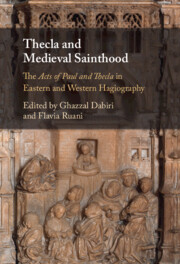Book contents
- Thecla and Medieval Sainthood
- Thecla and Medieval Sainthood
- Copyright page
- Contents
- Contributors
- Acknowledgments
- Abbreviations
- Introduction
- Part I An Act to Follow
- Part II An Act to Surpass
- Chapter 7 Thecla, the First Cross-Dresser?
- Chapter 8 From Diotima to Thecla and Beyond
- Chapter 9 Reception and Rejection
- Chapter 10 A Medieval Sufi Thecla?
- Afterword
- Appendix Summaries of Texts
- Index
- References
Chapter 10 - A Medieval Sufi Thecla?
Female Civic and Spiritual Leadership in ʿAttār’s “Tale of the Virtuous Woman” and the Life and Passion of Eugenia
from Part II - An Act to Surpass
Published online by Cambridge University Press: 06 May 2022
- Thecla and Medieval Sainthood
- Thecla and Medieval Sainthood
- Copyright page
- Contents
- Contributors
- Acknowledgments
- Abbreviations
- Introduction
- Part I An Act to Follow
- Part II An Act to Surpass
- Chapter 7 Thecla, the First Cross-Dresser?
- Chapter 8 From Diotima to Thecla and Beyond
- Chapter 9 Reception and Rejection
- Chapter 10 A Medieval Sufi Thecla?
- Afterword
- Appendix Summaries of Texts
- Index
- References
Summary
The “Tale of the Virtuous Woman” (TVW) by the Sufi hagiographer and poet, Farīd al-Dīn ʿAttār, is quite unique, as Sufi tales go, in its depiction of a woman from a well-to-do family: young, beautiful, and virtuous, she becomes a recognized spiritual and civic leader independently and in a foreign land. It, thus, invites further inquiry. It has been noted that the TVW, which appears in ʿAttār’s long narrative poem (masnavī), the Ilāhīnāmah (Book of the Divine), shares popular motifs with ancient romances. Detailed examinations reveal that it is closer in affinity to tales of female Christian saints and heroines, such as the Acts of Paul and Thecla, Life of Eugenia, Life and Miracles of Thecla, and Pseudo-Clementine Recognitions, in the way they adopt popular motifs for religio-spiritual aims. Strikingly, the former three and the TVW similarly depict independently attained female leadership. This article, thus, analyzes the versions of the TVW circulating in Iran and the possible routes the aforementioned Christian narratives circulated within and without the Iranian world. Then, it offers an analysis of the TVW and Life of Eugenia which, although separated in time, space, culture, and language, similarly explore female leadership and spiritual, familial, and civic conversion.
Keywords
- Type
- Chapter
- Information
- Thecla and Medieval Sainthood<I>The Acts of Paul and Thecla</I> in Eastern and Western Hagiography, pp. 282 - 317Publisher: Cambridge University PressPrint publication year: 2022



